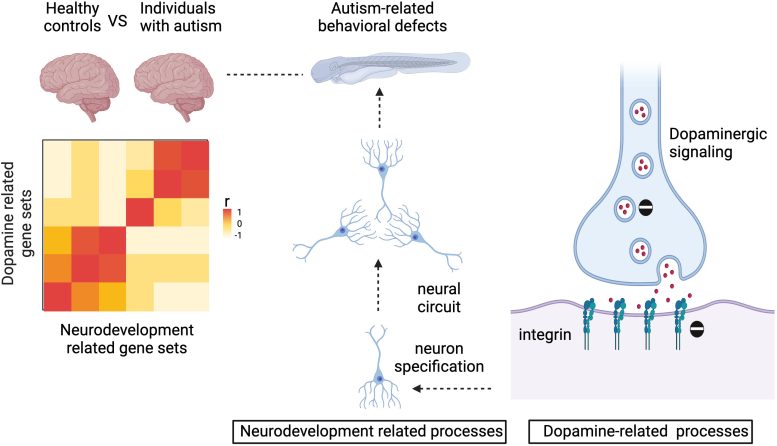
Developmental Twist – New Study Links Autism to Disrupted Dopamine
-
by Anoop Singh
- 12

Recent research has highlighted the significant role of dopamine in neural development and its link to autism spectrum disorder (ASD). Leading investigators from Nantong University discovered correlations between disrupted dopaminergic signaling and neural development abnormalities in both human and zebrafish models. These findings open new avenues for understanding autism’s etiology and developing targeted therapeutic interventions.
A new study reports that a new therapeutic target could transform how we treat autism spectrum disorder.
Recent research indicates that dopamine is critical in neural development. A novel study has shown a connection between impaired dopamine signaling during development and autism spectrum disorder (ASD). These results emphasize the need to explore developmental signaling pathways to grasp the origins of ASD, potentially leading to targeted treatments. The study was published in The American Journal of Pathology.
Lead investigators Lingyan Xing, PhD, and Gang Chen, PhD, Key Laboratory of Neuroregeneration of Jiangsu and the Ministry of Education, Co-innovation Center of Neuroregeneration, NMPA Key Laboratory for Research and Evaluation of Tissue Engineering Technology Products, Nantong University, explain, “While dopamine is commonly recognized as a neurotransmitter, its significance in the developmental aspects of autism is largely unexplored. Recent studies have highlighted the crucial roles of dopamine and serotonin in development and their importance in the construction of neural circuits. In addition, studies have indicated that the use of dopamine-related drugs during pregnancy is associated with an increased risk of autism in children. Armed with these tantalizing clues, we embarked on a mission to bridge the gap between dopamine’s known functions and its potential impact on neurodevelopmental disorders, particularly autism. Our quest was to uncover a novel therapeutic target that could revolutionize the way we approach autism treatment.”
Research Methodology and Findings
Investigators studied the role of disrupted dopaminergic signaling in the etiology of ASD by integrating human brain RNA sequencing transcriptome analysis and a zebrafish model, recognized for its high degree of conservation with humans.
To analyze the developmental deficits in ASD systematically, two large publicly available data sets were retrieved from the National Center for Biotechnology Information (NCBI) Gene Expression Omnibus database and RNA sequencing data from Arkinglab. Transcriptome analysis of human brains revealed significant correlations between changes in dopaminergic signaling pathways and neural developmental signaling in patients with autism. This suggests a potential link between disrupted developmental dopamine signaling and autism pathology.

This diagram shows that dopamine regulates neuron specification, suggesting its role in modulating neural circuits during development, potentially contributing to autism spectrum disorder–related phenotype. Credit: The American Journal of Pathology
To explore this link further researchers used the zebrafish model to study the effects of disrupted dopaminergic signaling on neural circuit development. They found that perturbations in developmental dopaminergic signaling led to neural circuit abnormalities and behavioral phenotypes reminiscent of autism in zebrafish larvae. The study also uncovered a potential mechanism by which dopamine impacts neuronal specification through the modulation of integrins.
Dr. Chen comments, “We were surprised by the extent of the impact that dopaminergic signaling has on neuronal specification in zebrafish, potentially laying the groundwork for circuit disruption in autism-related phenotype. Furthermore, the unexpected involvement of integrins as downstream targets of dopaminergic signaling provides new insights into the mechanisms underlying neurodevelopmental disorders.”
Dr. Xing concludes, “This research sheds light on the role of dopamine in neural circuit formation during early development, specifically in the context of autism. Understanding these mechanisms could lead to novel therapeutic interventions targeting dopaminergic signaling pathways to improve outcomes in individuals with autism and other neurodevelopmental disorders.”
ASD is a developmental disorder that usually manifests itself in early childhood. Although clinical outcomes vary greatly from case to case, autism is characterized by both a restricted interest in social interaction and repetitive behavior. This coincides with disruptions in brain connectivity shown by diffusion tension imaging. Studies have shown that several neurodevelopmental processes may be affected in ASD, including neurogenesis, neural migration, axon pathfinding, and synaptic formation, all of which can lead to neural circuit disruption.
Reference: “Developmental Dopaminergic Signaling Modulates Neural Circuit Formation and Contributes to Autism Spectrum Disorder–Related Phenotypes” by Xiaojuan Lu, Yixing Song, Jiaqi Wang, Yunyun Cai, Siwan Peng, Jiaqi Lin, Biqin Lai, Junjie Sun, Tianqing Liu, Gang Chen and Lingyan Xing, 16 March 2024, The American Journal of Pathology.
DOI: 10.1016/j.ajpath.2024.02.014
Recent research has highlighted the significant role of dopamine in neural development and its link to autism spectrum disorder (ASD). Leading investigators from Nantong University discovered correlations between disrupted dopaminergic signaling and neural development abnormalities in both human and zebrafish models. These findings open new avenues for understanding autism’s etiology and developing targeted therapeutic interventions.…
Recent research has highlighted the significant role of dopamine in neural development and its link to autism spectrum disorder (ASD). Leading investigators from Nantong University discovered correlations between disrupted dopaminergic signaling and neural development abnormalities in both human and zebrafish models. These findings open new avenues for understanding autism’s etiology and developing targeted therapeutic interventions.…
